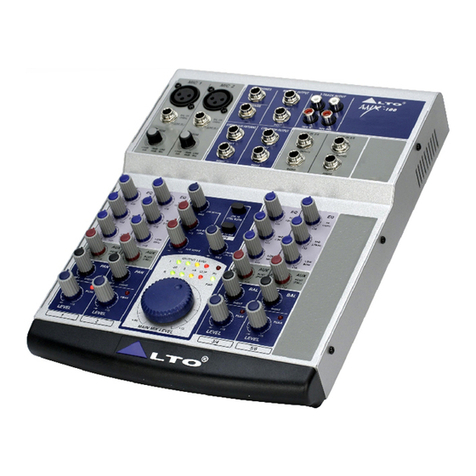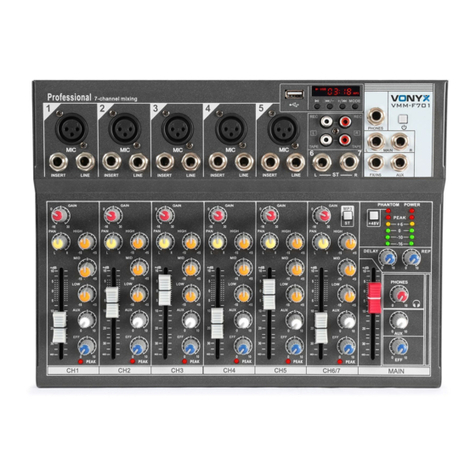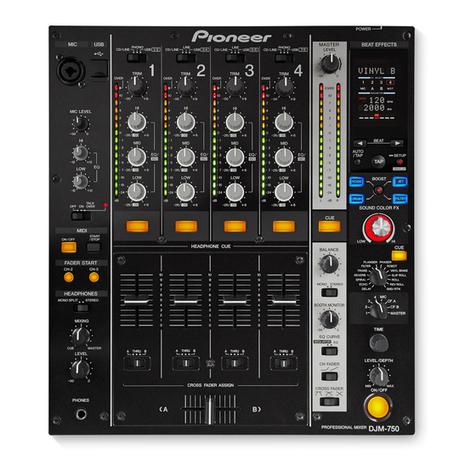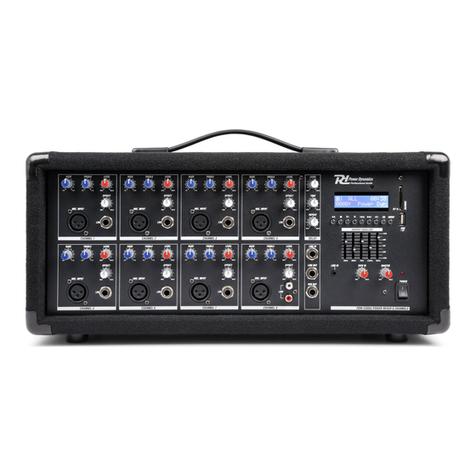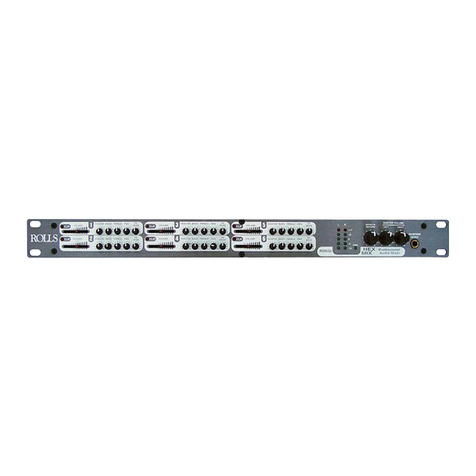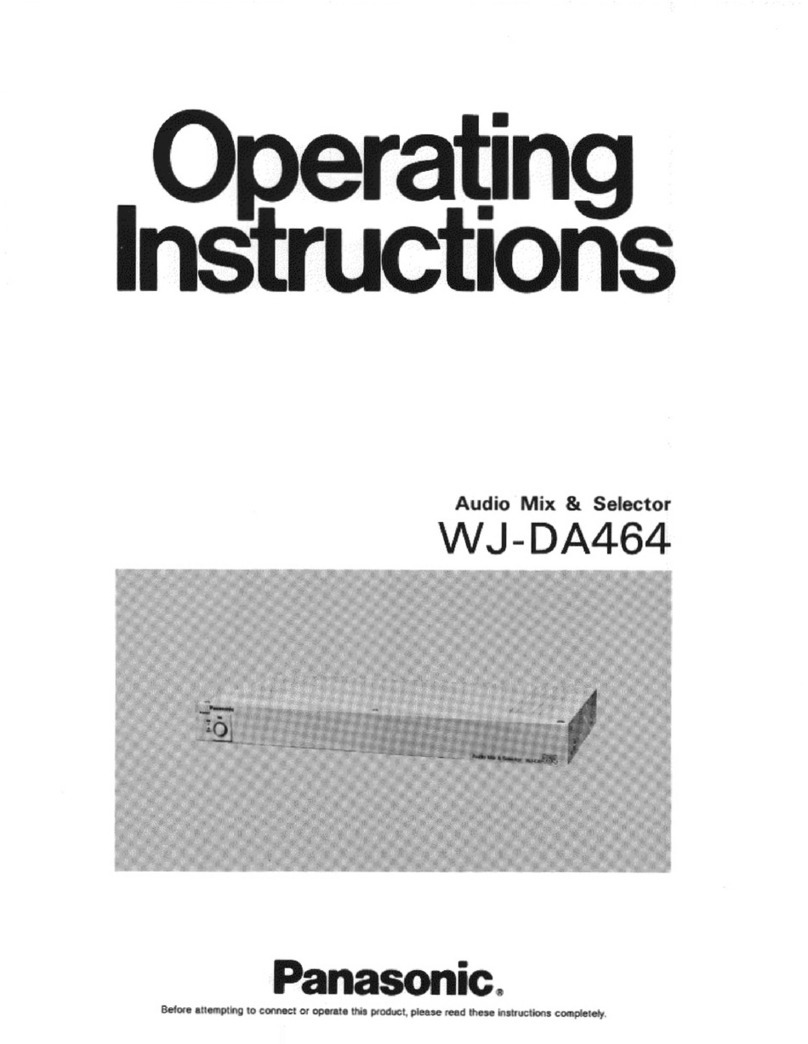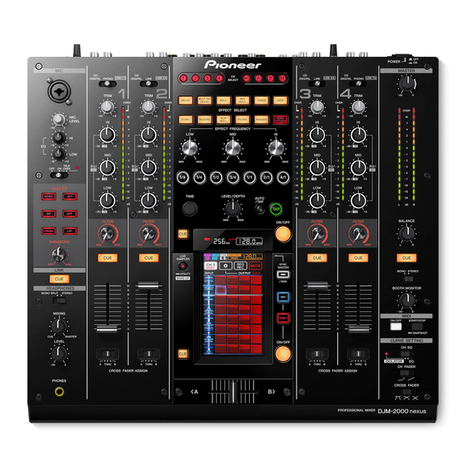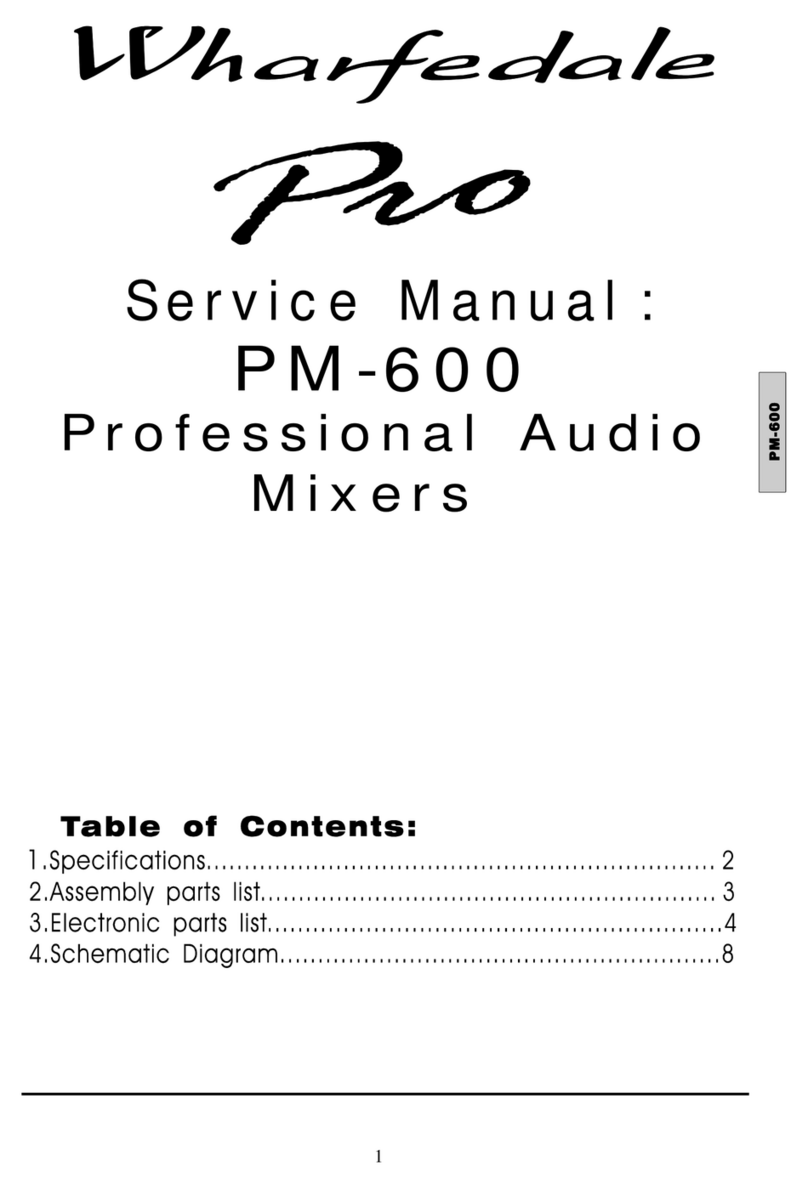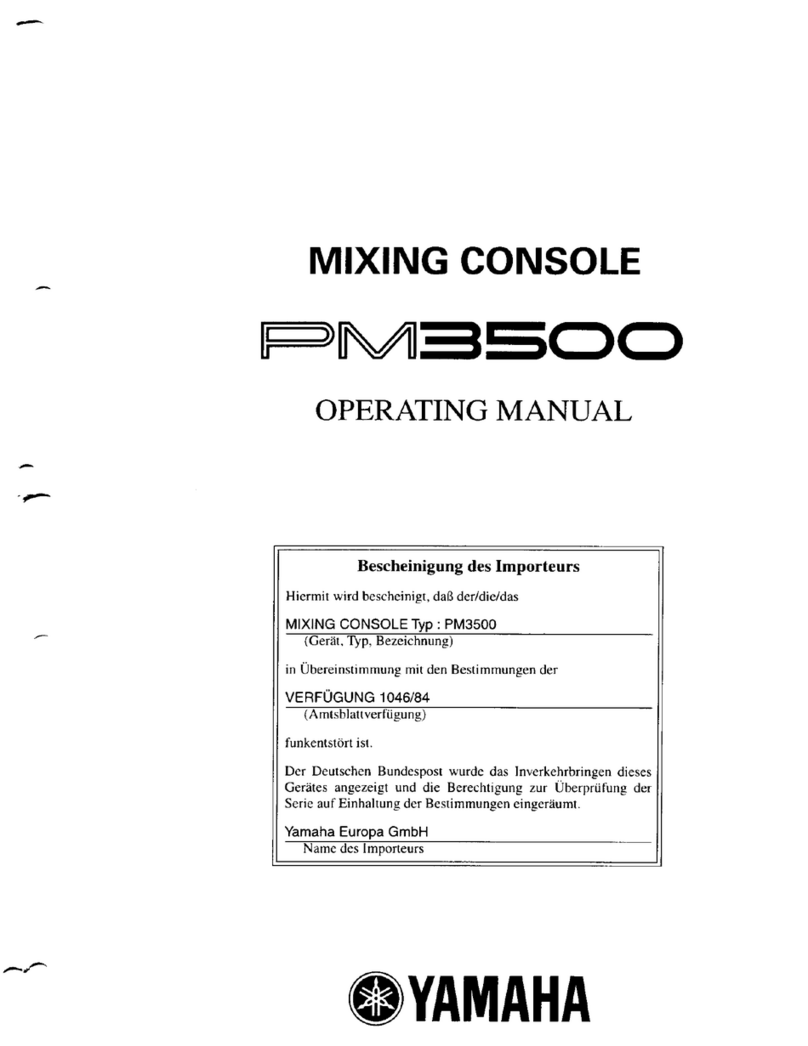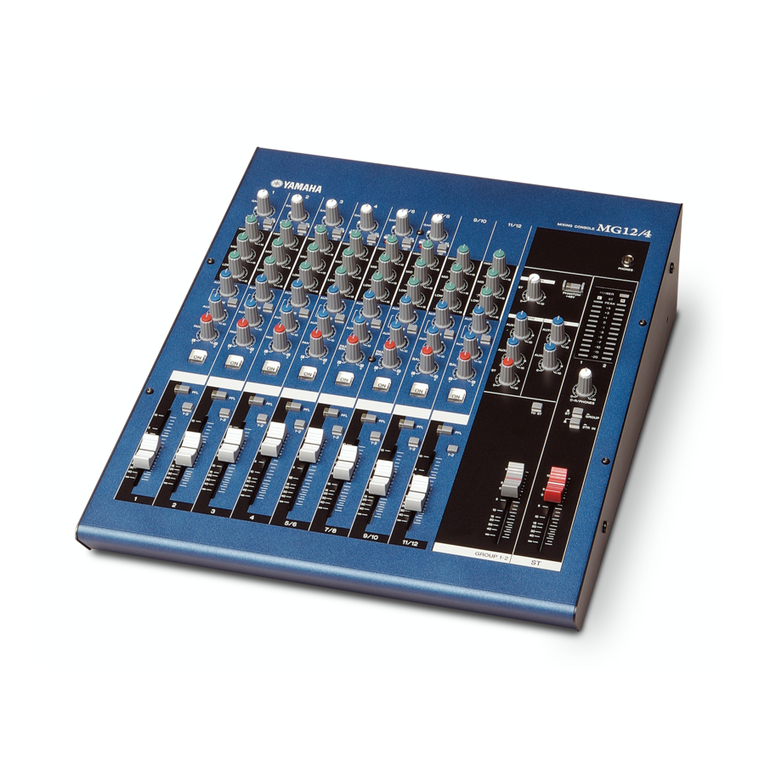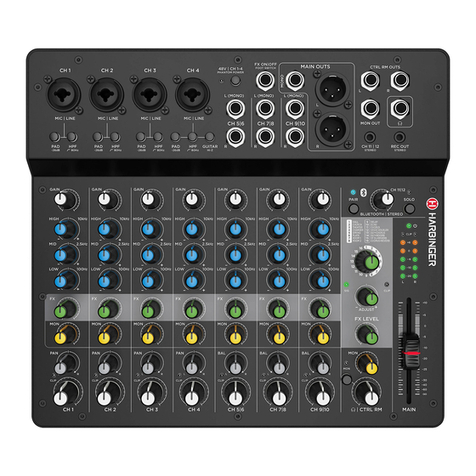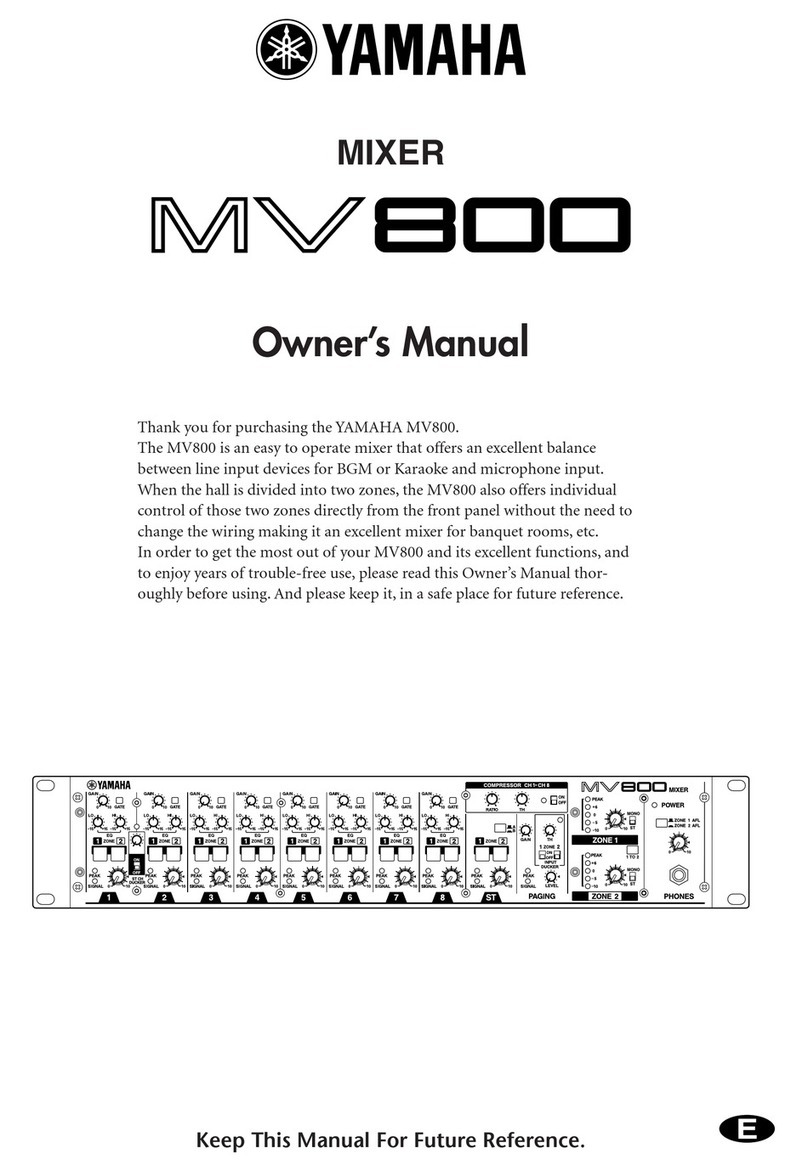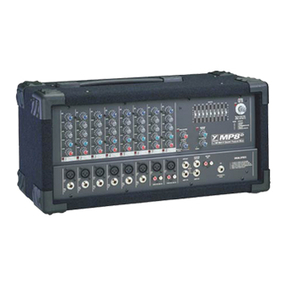GRADAV SoundCraft E8 User manual

Soundcraft E8 Mixer


1
SAFETYGUIDE
Page
SafetySymbolGuide 2
ApprovalsandNotice 3
Warranty 4
ImportantSafetyInstructions 5
Cautions 5
Warnings

2
USERGUIDE
SafetySymbolGuide
For your own safety and to avoid invalidation of the warranty all text marked with
these symbols should be read carefully.
CAUTIONS
Mustbefollowedcarefullytoavoidbodilyinjury.
WARNINGS
Mustbeobservedtoavoidda agetoyour
equip ent.
NOTES
Containi portantinfor ationandusefultipson
theoperationofyourequip ent.

3
IMPORTANT
Pleasereadthismanualcarefullybefore
connectingyourmixertothemainsforthefirst
time.
© Harman International Industries Ltd. 2 2
All rights reserved
Parts of the design of this product may be protected by worldwide patents.
Part No. ZM 262
Issue: 1
Soundcraft is a trading division of Harman International Industries Ltd. Information
in this manual is subject to change without notice and does not represent a com-
mitment on the part of the vendor. Soundcraft shall not be liable for any loss or
damage whatsoever arising from the use of information or any error contained in
this manual.
No part of this manual may be reproduced, stored in a retrieval system, or transmit-
ted, in any form or by any means, electronic, electrical, mechanical, optical, chemi-
cal, including photocopying and recording, for any purpose without the express
written permission of Soundcraft.
Harman International Industries Limited
Cranborne House
Cranborne Road
POTTERS BAR
Hertfordshire
EN6 3JN
UK
Tel: +44 ( )17 7 665
Fax: +44 ( )17 7 66 742
http://www.soundcraft.com

4
USERGUIDE
Warranty
1 Soundcraft is a trading division of Harman International Industries Ltd .
End User means the person who first puts the equipment into regular operation.
Dealer means the person other than Soundcraft (if any) from whom the End User
purchased the Equipment, provided such a person is authorised for this purpose by
Soundcraft or its accredited Distributor.
Equipment means the equipment supplied with this manual.
2 If within the period of twelve months from the date of delivery of the Equipment
tothe End User it shall prove defective by reason only of faulty materials and/or
workmanship to such an extent that the effectiveness and/or usability thereof is
materially affected the Equipment or the defective component should be returned to
the Dealer or to Soundcraft and subject to the following conditions the Dealer or
Soundcraft will repair or replace the defective components. Any components
replaced will become the property of Soundcraft.
3 Any Equipment or component returned will be at the risk of the End User whilst in
transit (both to and from the Dealer or Soundcraft) and postage must be prepaid.
4 This warranty shall only be valid if:
a) the Equipment has been properly installed in accordance with instructions
contained in Soundcrafts manual; and
b) the End User has notified Soundcraft or the Dealer within 14 days of the
defect appearing; and
c) no persons other than authorised representatives of Soundcraft or the Dealer
have effected any replacement of parts maintenance adjustments or repairs
to the Equipment; and
d) the End User has used the Equipment only for such purposes as Soundcraft
recommends, with only such operating supplies as meet Soundcrafts
specifications and otherwise in all respects in accordance with Soundcrafts
recommendations.
5 Defects arising as a result of the following are not covered by this Warranty: faulty or
negligent handling, chemical or electro-chemical or electrical influences, accidental
damage, Acts of God, neglect, deficiency in electrical power, air-conditioning or
humidity control.
6 The benefit of this Warranty may not be assigned by the End User.
7 End Users who are consumers should note their rights under this Warranty are in
addition to and do not affect any other rights to which they may be entitled against
the seller of the Equipment.

5
IMPORTANTSAFETYINSTRUCTIONS
CAUTIONS
To avoid the risk of fire, replace the mains fuse only with the correct type and value
fuse, as marked on the bottom of the product.
ATTENTION: - Afin de réduire le risque de feu remplacer seulement avec fusible de
même type.
MAINS VOLTAGE SELECTION
This setting is NOT User Adjustable.
The units are capable of operating at either 23 V AC or 115V AC mains voltages ±1 %.
REPLACING MAINS FUSE
Remove the mains lead from the connector. Use a small screwdriver to unscrew the
fuse carrier from its location to the left of the mains power connector. Check the fuse is
of the correct type and value and replace if necessary; also check that the voltage
selection as marked on the rear panel is correct for the mains supply level before
switching the unit ON again.
If the mains fuse fails repeatedly this may be because an electrical safety hazard
exists. The unit must be taken out of service and referred to the Soundcraft dealer from
where the equipment was purchased.
THIS UNIT MUST BE EARTHED
Under no circumstances should the mains earth be disconnected from the mains lead.
ATTENTION: - Cet appareil doit être branché à la terre.
The wires in the mains lead are coloured in accordance with the following code:
Replacement Part No: FJ8 16 (UK) : FJ8 17 (EU) : FJ8 18 (US & CAN)
UK & EU US & CAN
Earth / Ground: Green and Yellow Green and Yellow
Neutral: Blue White
Live: Brown Black
As the colours of the wires in the mains lead may not correspond with the coloured
markings identifying the terminals in your plug, proceed as follows:
The wire which is coloured Green and Yellow must be connected to the terminal in the
plug which is marked with the letter E or by the earth / ground symbol:
The wire which is coloured Blue or White must be connected to the terminal in the plug
which is marked with the letter N.
The wire which is coloured Brown or Black must be connected to the terminal in the
plug which is marked with the letter L.
Ensure that these colour codings are followed carefully in the event of the plug being
changed.
Do not install near any heat sources such as radiators, heat resistors, stoves, or other
apparatus (including amplifiers) that produce heat.

6
USERGUIDE
Do not use this apparatus near water. The apparatus must not be exposed to dripping
or splashing. Objects containing liquid must not be placed on the apparatus.
The disconnect device is the mains plug or the appliance connector: either one must
remain accessible so as to be readily operable in use.
Do not defeat the safety purpose of the polarized or grounding type plug.
A polarized plug has two blades with one wider than the other. A grounding type plug
has two blades and a third grounding prong. The wide blade or the third prong are
provided for your safety. When the provided plug doesnot fit into your outlet, consult
an electrician for replacement of the obsolete outlet.
Protect the power cord from being walked on or pinched particularly at plugs, conven-
ience receptacles and the point where they exit from the apparatus.
Only use cables and hardware specified by the manufacturer.
Unplug this apparatus during lightning storms or when unused for long periods of time.
Refer all servicing to qualified service personnel. Servicing is required when the appa-
ratus has been damaged in any way such as power-supply cord or plug is damaged.,
liquid has been spilled or objects have fallen into the apparatus, the apparatus has
been exposed to rain or moisture, does not operate normally or has been dropped.
It is recommended that all maintenance and service on the product should be carried
out by Soundcraft or its authorised agents. Soundcraft cannot accept any liability what-
soever for any loss or damage caused by service, maintenance or repair by unauthor-
ised personnel.
If a trolley is used, use caution when moving the trolley / apparatus combination to
avoid injury from tip-over.
WARNINGS
Read these instructions.
Keep these instructions.
Heed all warnings.
Follow all instructions.
This unit contains no user serviceable parts. Refer all servicing to a qualified service
engineer, through the appropriate Soundcraft dealer.
Clean the apparatus only with a dry cloth.
DO NOT block any of the ventilation openings. DO NOT install where air cannot flow over
the rear of the unit. DO Install in accordance with the manufacturers instructions.

7
Page
Overview 8
The10SecondTutor 9
Introduction 10
AdviceforThoseWhoPushtheBoundaries 10
Installation&SafetyPrecautions 11
Wiring p 12
MonoInputChannels 16
StereoInputChannels 19
MasterSection 22
singYourSpiritESConsole 24
FittingRackmountEars 26
Application1LiveSoundReinforcement 27
Application2Broadcast 28
Application3Recording 28
Application4KeyboardSubMixer 29
Application5LinkingTwoSpiritESConsoles 29
Glossary 30
TypicalSpecifications 32
Dimensions 34
SystemBlockDiagram 35
TypicalConnectingLeads 36
ControlPositionMarkupSheet 38
CONTENTS

8
USERGUIDE
Overview
To get you working as fast as possible, this manual begins with a 1 second tutorial. Here you can find quick information on any feature
of the console, and a page reference where you can find a more detailed explanation.
1
t
2
3
4
5
6
7
8
9
p
y
d
0
q
u
i
g
h
f
s
e
w
o
ar

9
THE10SECONDTUTOR
1 MIC INPUT (XLR) Connect Microphones here. If you are using a condenser mic, ensure phantom power
is supplied by pressing the switch at the top of the master section g
WARNING: Do Not apply Phantom Power before connecting a microphone
2 LINE INPUT (¼ Jack) Connect Line level sources here, e.g. Synth, Drum Machine, DI etc
3 INSERT POINT (¼ Jack) Connect Signal processors here, e.g. Compressor, Gate etc
4 GAIN CONTROL Adjust this to increase or decrease the level of the incoming signal
5 EQ STAGE Adjust these controls to change the signal tone (the character of the signal)
6 AUX SENDS Adjust these controls to change the level of the signal to an FX unit or an artists
monitors (headphones/in-ear/stage monitors). Aux 1&2 are switchable pre/post
fade
7 PAN/BAL CONTROL Use this control to position /Balance the signal within the stereo field
8 MUTE SWITCH When this is pressed you will hear no signal from the channel (post-mute signals)
9 SOLO When pressed the signal will appear on the monitor outputs - use this to monitor the
post EQ signal from the channel
0 PEAK LED This is used to indicate that the signal close to distorting (clipping) on a specific
channel
q INPUT CHANNEL ADER This is used to control the level fed to the Mix Bus and post-fade sends
w MIX OUTPUTS (XLR) Connect these to your analogue recording device, or to your amplification system
e MIX INSERTS (¼ Jack) This is a pre-fade break in the signal path which can be used to feed a dynamics or
mastering device. The signal is sent from the tip of the jack plug and the return path
comes back in on the ring of the jack plug
r MONITOR O/Ps (¼ Jack) These are used to feed your monitoring system. This can be directly connected to
powered monitors, or indirectly via an amplifier to standard monitors
t MASTER ADERS These faders control the overall level of the mix bus
y MAIN METERS These show the level of the mix outputs. When the SOLO LED is lit, the meters show
the level of the signal sourced
u MONITOR CONTROL This controls the level of the signal sent to your monitoring system
i PHONES CONTROL This controls the level of the signal sent to the headphones jack socket
o AUX OUTPUTS (¼ Jack) These two outputs can be used to send the channel signal to an FX unit or an artists
monitors (headphones/in-ear/stage monitors). Aux 1&2 are switchable pre/post
fade
p AUX SWITCHING These two switches globally switch the AUX1 and AUX2 feeds respectively, on all the
input modules to be either pre or post-fade
a STEREO INPUTS (¼ Jack) These ten stereo inputs can be used to connect line level stereo inputs from keyboards,
sound modules, samplers, computer based audio cards etc. Channels 1 & 2 can accept
inputs from turntables, while input 3-6 have optional RCA inputs.
s PLAYBACK INPUTS (Phono) Here you can connect the playback from your recording device
d PLAYBACK CONTROLS Use these to control the playback signal. The MONITOR PLAYBACK switch sends the
signal to the monitor outputs and phones, whilst the PLAYBACK TO MIX switch sends it
to the main mix
f RECORD OUTPUTS Here you can connect the input to your recording device
g PHANTOM POWER Press this to switch the phantom power (48V) on for condenser microphones
WARNING: Do Not apply Phantom Power before connecting a microphone
h HEADPHONES (¼ Jack) Plug your headphones into this socket

1
USERGUIDE
INTRODUCTION
Thank you for purchasing a Soundcraft mixer. We take great pride in our latest addition to the
Spirit range of mixing consoles - you have taken a step in the right direction and should never
look back.
The packaging which your Spirit E Series arrived in, forms part of the product and must be
retained for future use.
Owning a Soundcraft console brings you the expertise and support of one of the industrys
leading manufacturers, and the results of nearly 3 decades of supporting some of the biggest
names in the business. Our knowledge has been attained through working in close contact with
leading professionals and institutes to bring you products designed to get the best possible
results from your mixing.
Built to the highest standards using quality components and surface mount technology, the
Spirit E Series is designed to be as easy to use as possible. We have spent years researching
the most efficient methods of control for two key reasons:
1) Engineers, musicians, writers and programmers all need to have very few interruptions to the
creative process; our products have been designed to be almost transparent, allowing this
process to breathe.
2) Whether performing or recording, time is a very expensive and rare commodity. Our products
have a user interface which is recognised by millions to be the industry standard because of its
efficiency.
The sonic qualities of our products are exemplary - some of the same circuits which are used on
our most expensive consoles are employed in the Spirit E Series, bringing you the great Soundcraft
quality in a small format console without compromise.
You will also be glad to know you have a one year warranty with your product from the date of
purchase. The Spirit E Series has been designed using the latest high-end software based
engineering packages. Every console from Soundcraft has been proven to stand up to all the
stress and rigours of modern day mixing environments.
The entire Spirit E Series is manufactured using some of the most advanced techniques in the
world, from high density surface mount PCB technology, to computer aided test equipment able
to measure signals well outside the range of normal hearing. As each console passes through
to be quality checked before packing, there is also a human listening station. Something we
have learnt over the years is that the human touch counts - and only by using people can you
ensure the product meets the high demands of the user.
ADVICEFORTHOSEWHOPUSHTHEBOUNDARIES
Although your new console will not make any noise until you feed it signals, it has the capability
to produce sounds which when monitored through an amplifier or headphones can damage
hearing over time.
Please take care when working with your audio - if you are manipulating controls which you
dont understand (which we all do when we are learning), make sure your monitors are turned
down. Remember that your ears are the most important tool of your trade, look after them, and
they will look after you.
Most importantly - dont be afraid to experiment to find out how each parameter affects the
sound - this will extend your creativity and help you to get the best from your mixer and the
most respect from your artists and audience.

11
INSTALLATIONANDSAFETYPRECAUTIONS
ABOUTTHISMANUAL
This manual describes the safety precautions, warnings, specifications, installation and operat-
ing procedures specific to the following Soundcraft products only:
Spirit ES RW5653 UK / EU / US
The information in this manual should be read by end users of one of the above products only.
In particular, this manual should not be read in conjunction with any other product not listed
above.
The above products do not contain any user-serviceable parts and the user guide does not
contain any technical servicing information. Qualified service personnel can obtain a separate
Technical Manual incorporating the user guide, Part No ZM 262 from Soundcraft or one of its
accredited distributors.
Information in this manual is subject to change without notice and does not represent a com-
mitment on the part of the vendor. Soundcraft shall not be liable for any loss or damage
whatsoever arising from the use of information or any error contained in this manual.
INSTALLINGTHEMIXER
Correct connection and positioning of your mixer is important for successful and trouble-free
operation. The following sections are intended to give guidance with cabling, connections and
configuration of your mixer.
Choose the mains supply for the sound system with care, and do not share sockets or
earthing with lighting dimmers.
Position the mixer where the sound can be heard clearly.
Run audio cables separately from dimmer wiring, using balanced lines wherever possi-
ble. If necessary, cross audio and lighting cables at right angles to minimise the pos-
sibility of interference. Keep unbalanced cabling as short as possible.
Check your cables regularly and label each end for easy identification.
SAFETYPRECAUTIONS
For your own safety and to avoid invalidation of the warranty please read this section carefully.
In particular, you should also read the Cautions and Warnings on pages 5-6 of this manual.
TheconsolemustonlybeconnectedtotheMainsVoltage
indicatedontherearpanel.
Toavoidtheriskoffire,replacethemainsfuseonlywith
thecorrectvaluefuse,asindicatedontherearpanel.
GeneralPrecautions
Do not obstruct any of the ventilation openings.
Avoid storing or using the mixer in conditions of excessive heat or cold, or in positions
where it is likely to be subject to vibration, dust or moisture.
Keep the mixer clean using a soft dry brush, and an occasional wipe with a damp cloth
or ethyl alcohol. Do not use any other solvents which may cause damage to paint or
plastic parts.
Avoid placing drinks or smoking materials on or near the mixer. Sticky drinks and ciga-
rette ash are frequent causes of damage to faders and switches.
Regular care and inspection will be rewarded by a long life and maximum reliability.

12
USERGUIDE
WIRINGUP
Please refer to pages 36/37 for additional wiring details.
MicInputs1-4
The MIC input accepts XLR-type connectors and is designed to suit a wide range of
BALANCED or UNBALANCED low-level signals, whether from delicate vocals requir-
ing the best low-noise performance, or drum kits needing maximum headroom.
Professional dynamic, condenser or ribbon mics are best because these will be
LOW IMPEDANCE. While you can use low-cost HIGH IMPEDANCE mics, you do not
get the same degree of immunity to interference on the microphone cable and as a
result the level of background noise may be higher. If you turn the PHANTOM
POWER on, the socket provides a suitable powering voltage for professional con-
denser mics.
The input level is set using the input GAIN knob.
The LINE input offers the same gain range as the MIC input, but at a higher input
impedance, and is 2 dB less sensitive. This is suitable for most line level sources.
LineInput
Accepts 3-pole A gauge jacks, or 2-pole mono jacks which will automatically ground
the cold input. Use this input for sources other than mics, such as keyboards,
drum machines, synths, tape machines or guitars. The input is BALANCED for low
noise and immunity from interference, but you can use UNBALANCED sources by
wiring up the jacks as shown, although you should then keep cable lengths as short
as possible to minimise interference pick-up on the cable. Note that the ring must
be grounded if the source is unbalanced. Set the input level using the GAIN knob,
starting with the knob turned fully anticlockwise. Unplug any MIC connection when
using the LINE input.
InsertPoint
The unbalanced, pre-EQ insert point is a break in the channel signal path, allowing
limiters, compressors, special EQ or other signal processing units to be added in
the signal path. The Insert is a 3-pole A gauge jack socket which is normally
bypassed. When a jack is inserted, the signal path is broken, just before the EQ
section.
The signal from the channel appears on the TIP of the plug and is returned on the
RING, with the sleeve as a common ground.
The Send may be tapped off as an alternative pre-fade, pre-EQ direct output if
required, using a lead with tip and ring shorted together so that the signal path is
not interrupted.
DONOTuseUNBALANCEDsourceswiththe
phantompowerswitchedon.Thevoltageonpins
2& oftheXLRconnectormaycauseserious
damage.BALANCEDdynamicmicsmaynormally
beusedwithphantompowerswitchedon
(contactyourmicrophonemanufacturerfor
guidance)
WARNING!
StartwiththeinputGAINknobturnedfully
anticlockwisewhenplugginghighlevelsources
intotheLINEinputtoavoidoverloadingtheinput
channelorgivingyouaveryloudsurprise!

13
Stereo Inputs 1-10
These accept 3-pole A gauge jacks, or 2-pole mono jacks which will automatically
ground the cold input. Use these inputs for sources such as keyboards, drum
machines, synths, tape machines or as returns from processing units. The input is
BALANCED for low noise and immunity from interference, but you can use
UNBALANCED sources by wiring up the jacks as shown, although you should then
keep cable lengths as short as possible to minimise interference pick-up on the
cable. Note that the ring must be grounded if the source is unbalanced.
Mono sources can be fed to both paths by plugging into the Left jack only (NB
Channels 3-6 have a dedicated mono switch to perform this function) .
MixInserts
The unbalanced, pre-fade Mix insert point is a break in the output signal path to
allow the connection of, for example, a compressor/limiter or graphic equaliser.
The Insert is a 3-pole A gauge jack socket which is normally bypassed. When a
jack is inserted, the signal path is broken, just before the mix fader.
The mix signal appears on the TIP of the plug and is returned on the RING. A Y lead
may be required to connect to equipment with separate send and return jacks as
shown below:
MixOutputs
The MIX outputs are on XLRs, wired as shown, and incorporate impedance balanc-
ing, allowing long cable runs to balanced amplifiers and other equipment.

14
USERGUIDE
AuxOutputs
The Aux outputs are on 3-pole A gauge jack sockets, wired as shown on the left, and
are balanced, allowing long cable runs to balanced amplifiers and other equipment.
Headphones
The PHONES output is a 3-pole A gauge jack, wired as a stereo output as shown,
ideally for headphones of 2 W or greater. 8W headphones are not recommended.
Polarity(Phase)
You will probably be familiar with the concept of polarity in electrical signals and
this is of particular importance to balanced audio signals. Just as a balanced
signal is highly effective at cancelling out unwanted interference, so two micro-
phones picking up the same signal can cancel out, or cause serious degradation of
the signal if one of the cables has the +ve and -ve wires reversed. This phase
reversal can be a real problem when microphones are close together and you should
therefore always take care to connect pins correctly when wiring audio cables.
GroundingandShielding
For optimum performance use balanced connections where possible and ensure
that all signals are referenced to a solid, noise-free earthing point and that all signal
cables have their screens connected to ground. In some unusual circumstances, to
avoid earth or ground loops ensure that all cable screens and other signal earths
are connected to ground only at their source and not at both ends.
If the use of unbalanced connections is unavoidable, you can minimise noise by
following these wiring guidelines:
On INPUTS, unbalance at the source and use a twin screened cable as
though it were balanced.
On OUTPUTS, connect the signal to the +ve output pin, and the ground of
the output device to -ve. If a twin screened cable is used, connect the
screen only at the mixer end.
Avoid running audio cables or placing audio equipment close to thyristor
dimmer units or power cables.
Noise immunity is improved significantly by the use of low impedance
sources, such as good quality professional microphones or the outputs from
most modern audio equipment. Avoid cheaper high impedance micro-
phones, which may suffer from interference over long cable runs, even with
well-made cables.
Grounding and shielding is still seen as a black art, and the suggestions above are
only guidelines. If your system still hums, an earth/ground loop is the most likely
cause. Two examples of how an earth loop can occur are shown below.
WARNING!UnderNOcircumstancesmusttheAC
powermainsearthbedisconnectedfromthemains
lead.

15
PROBLEMSOLVING
Basic problem solving is within the scope of any user if a few basic rules are
followed.
Get to know the Block Diagram of your console (see page 38).
Get to know what all parameters and/or connections in the system are
supposed to do.
Learn where to look for common trouble spots.
The Block Diagram is a representative sketch of all the components of the con-
sole, showing how they connect together and how the signal flows through the
system. Once you have become familiar with the various component blocks you
will find the Block Diagram is quite easy to follow and you will have gained a
valuable understanding of the internal structure of the console.
Each Component has a specific function and only by getting to know what each
part is supposed to do will you be able to tell if there is a genuine fault! Many
faults are the result of incorrect connection or control settings which may have
been overlooked.
Basic Troubleshooting is a process of applying logical thought to the signal path
through the console and tracking down the problem by elimination.
Swap input connections to check that the source is really present. Check
both Mic and Line inputs.
Eliminate sections of the channel by using the insert point to re-route the
signal to other inputs that are known to be working.
Route channels to different outputs or to auxiliary sends to identify prob-
lems on the Master section.
Compare a suspect channel with an adjacent channel which has been
set up identically. Use SOLO to monitor the signal in each section.
Insert contact problems may be checked by using an insert bypass jack
with tip and ring shorted together as shown below. If the signal appears
when the jack is inserted it shows that there is a problem with the
normalling contacts on the jack socket, caused by wear or damage, or
often just dirt or dust. Keep a few in your gig tool box.
If in doubt please contact Soundcraft customer support.
PRODUCTSUNDERWARRANTY
USA customers should contact the National Service Manager at Soundcraft USA,
UK customers should contact their local Dealer.
Outside the UK and USA, customers are requested to contact their territorial
distributor who is able to offer support in the local time zone and language.
Please see the Distributor listings on our website (http://www.soundcraft.com)
to locate your Local Distributor.
OUT-OF-WARRANTYPRODUCTS
For out-of-warranty consoles purchased in the United Kingdom, please contact
the Customer Services Department (e-mail: [email protected]) at the factory
in Potters Bar, Hertfordshire: Telephone +44 ( )17 7 665 .
For all other out-of-warranty consoles, please contact the appropriate territorial
distributor.
When mailing or faxing please remember to give as much information as possi-
ble. This should include your name, address and a daytime telephone number.
Should you experience any difficulty please contact Customer Services Depart-
ment (e-mail: [email protected])

16
USERGUIDE
MONOINPUTCHANNELS
1
MicInput
The MIC input accepts XLR-type connectors and is designed to suit a wide range of
BALANCED or UNBALANCED signals. Professional dynamic, condenser or ribbon mics
are best because these will be LOW IMPEDANCE. You can use low-cost HIGH IMPED-
ANCE mics, but the level of background noise will be higher. If you turn the PHANTOM
POWER on (top right-hand side of the mixer) the socket provides a suitable powering
voltage for professional condenser mics.
TAKE CARE when using unbalanced sources, which may be damaged by the phantom
power voltage on pins 2 & 3 of the XLR connector.
Unplug any mics if you want to use the LINE Input. The input level is set using the GAIN
knob.
2
LineInput
Accepts 3-pole A gauge (TRS) jacks. Use this input for sources other than mics, such
as keyboards, drum machines, synths, tape machines or DId guitars. The input is
BALANCED for low noise and top quality from professional equipment, but you can use
UNBALANCED sources by wiring up the jacks as shown below, although you should then
keep cable lengths as short as possible. Unplug anything in the MIC input if you want to
use this socket. Set the input level using the GAIN knob.
3
InsertPoint
The unbalanced, pre-EQ insert point is a break in the channel signal path, allowing
limiters, compressors, special EQ or other signal processing units to be added in the
signal path. The Insert is a 3-pole A gauge jack socket which is normally bypassed.
When a jack is inserted, the signal path is broken, just before the EQ section.
The Send may be tapped off as an alternative pre-fade, pre-EQ direct output if required,
using a lead with tip and ring shorted together so that the signal path is not interrupted
(see below).
ONLYconnectcondensermicrophoneswiththe+48V
poweringOFF,andONLYturnthe+48Vpoweringon
oroffwithalloutputfadersDOWN,toprevent
damagetothemi erore ternaldevices.
q
7
1
2
3
4
5
6
8
0
9

17
4
Gain
This knob sets how much of the source signal is sent to the rest of the mixer. Too high, and
the signal will distort as it overloads the channel. Too low, and the level of any background
hiss will be more noticeable and you may not be able to get enough signal level to the
output of the mixer.
Note that some sound equipment, particularly that intended for domestic use, operates at
a lower level (-1 dBV) than professional equipment and will therefore need a higher gain
setting to give the same output level.
See Initial Setup on page 23 to learn how to set GAIN correctly.
5
Equaliser
The Equaliser (EQ) allows fine manipulation of the sound, particularly to improve the
sound in live PA applications where the original signal is often far from ideal and where
slight boosting or cutting of particular voice frequencies can really make a difference to
clarity. There are three sections giving the sort of control usually only found on much larger
mixers. The EQ knobs can have a dramatic effect, so use them sparingly and listen
carefully as you change any settings so that you get to know how they affect the sound.
H EQ
Turn to the right to boost high (treble) frequencies above 12kHz by up to 15dB, adding
crispness to cymbals, vocals and electronic instruments. Turn to the left to cut by up to
15dB, reducing hiss or excessive sibilance which can occur with certain types of micro-
phone. Set the knob in the centre-detented position when not required.
MID EQ
There are two knobs which work together to form a SWEPT MID EQ. The lower knob
provides 15dB of boost and cut, just like the HF EQ knob, but the frequency at which this
occurs can be set by the upper knob over a range of 14 Hz to 3kHz. This allows some
truly creative improvement of the signal in live situations, because this mid band covers
the range of most vocals. Listen carefully as you use these controls together to find how
particular characteristics of a vocal signal can be enhanced or reduced. Set the lower
knob to the centre-detented position when not required.
L EQ
Turn to the right to boost low (bass) frequencies below 6 Hz by up to 15dB, adding
warmth to vocals or extra punch to synths, guitars and drums. Turn to the left to cut low
frequencies by up to 15dB for reducing hum, stage rumble or to improve a mushy sound.
Set the knob to the centre-detented position when not required.
6
AuxSends
These are used to set up separate mixes for FOLDBACK, EFFECTS or recording, and the
combination of each Aux Send is mixed to the respective Aux Output. For Effects it is
useful for the signal to fade up and down with the fader (this is called POST-FADE), but for
Foldback or Monitor feeds it is important for the send to be independent of the fader (this
is called PRE-FADE).
AUX SENDS 1 and 2 are both globally switchable between pre and post-fade (see master
section on page 21/22).
7
PAN
This control sets the amount of the channel signal feeding the Left and Right MIX buses,
allowing you to move the source smoothly across the stereo image. When the control is
turned fully left or right you are able to route the signal at unity gain to either left or right
outputs individually.

18
USERGUIDE
8
MUTE
All outputs from the channel except inserts are on when the MUTE switch is released and
muted when the switch is down, allowing levels to be pre-set before the signal is required.
9
INPUTCHANNELFADER
The 1 mm FADER, with a custom-designed law to give even smoother control of the
overall signal level in the channel strip, allows precise balancing of the various source
signals being mixed to the Master Section. You get most control when the input GAIN is
set up correctly, giving full travel on the fader. See the Initial Setup section on page 23
for help in setting a suitable signal level.
0
SOLO
When the latching SOLO switch is pressed, the pre-fade pre-mute signal is fed to the
headphones, control room output and meters, where it replaces the MIX. The SOLO LED
on the Master section illuminates to warn that a SOLO is active. This is a useful way of
listening to any required input signal without interrupting the main mix, for making adjust-
ments or tracing problems. When SOLO is pressed anywhere on the console, the Control
Room outputs automatically switch from monitoring the Mix Outputs.
q
PEAKLED
This LED will light when the signal level approaches clipping at any of the three monitored
points:
a) PRE-EQ
b) POST-EQ
c) POST-FADE
q
7
1
2
3
4
5
6
8
0
9
Table of contents
